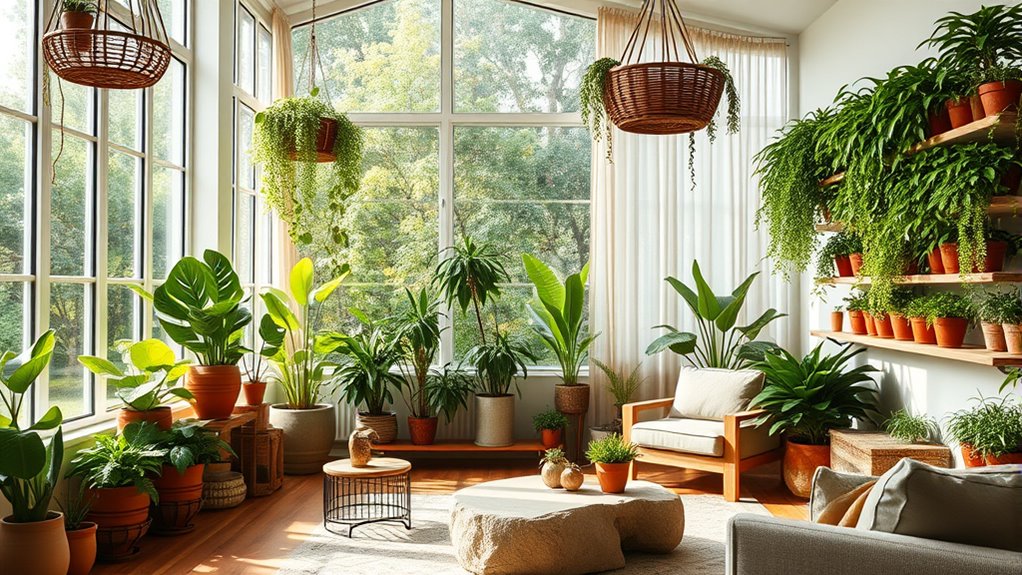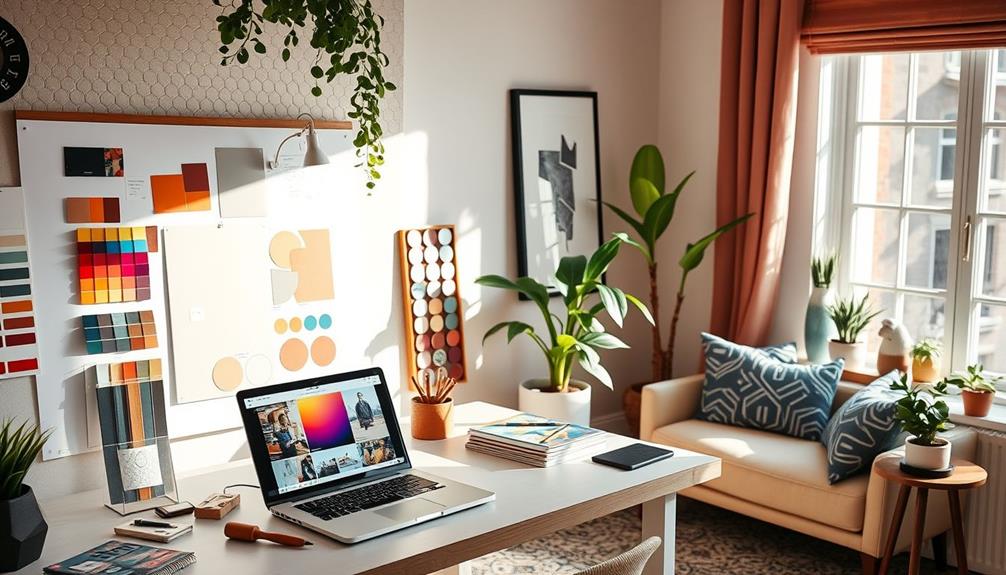Biophilic interior design helps you bring nature into your home by incorporating natural light, organic materials, and lush plant life. You can create outdoor-inspired views through large windows and use textures like wood and stone to evoke calm and authenticity. Sustainable practices, such as using eco-friendly materials and water-saving fixtures, enhance both well-being and the environment. To learn more about transforming your space into a harmonious, nature-connected haven, keep exploring these inspiring design principles.
Key Takeaways
- Incorporate natural materials, textures, and earthy tones to evoke a calming, organic environment aligned with biophilic principles.
- Maximize natural light through large windows, skylights, and minimal window treatments to create bright, inviting spaces.
- Integrate indoor plants and greenery to improve air quality, enhance visual interest, and foster emotional well-being.
- Design views of outdoor vistas or garden spaces to establish a seamless connection between indoors and nature.
- Use sustainable practices such as renewable energy, eco-friendly materials, and water conservation to promote environmentally conscious living.
Understanding the Principles of Biophilic Design

Understanding the principles of biophilic design begins with recognizing its core goal: creating indoor environments that foster a strong connection to nature. You do this by integrating biophilic patterns that mimic natural forms, textures, and layouts, making spaces feel organic and inviting. Sensory engagement is key; you want to stimulate sight, sound, smell, touch, and even taste to deepen your experience of the space. Incorporating elements like natural materials, plant life, and views of the outdoors helps activate your senses and enhances well-being. The idea isn’t just aesthetics—it’s about designing spaces that nurture your body and mind through a natural, engaging environment. By understanding these principles, you create interiors that genuinely resonate with nature’s calming and restorative qualities. Emphasizing natural materials and organic layouts can significantly improve the overall harmony and comfort of the space. Additionally, paying attention to sensory engagement can help you craft a more immersive and restorative environment that promotes relaxation and well-being. Incorporating biophilic patterns is essential for fostering a true connection to nature within indoor spaces, and selecting appropriate natural elements can further enhance this relationship. Incorporating experiential design strategies can deepen the sensory experience and promote healing and relaxation in the environment.
Incorporating Natural Light for a Vibrant Atmosphere

Natural light plays a essential role in creating a vibrant and inviting interior. To maximize its impact, focus on designing sunlit corners where sunlight naturally gathers, making these spots perfect for reading or relaxing. Proper skylight placement is essential; position skylights to direct sunlight into key areas without causing glare or overheating. Use large windows or glass doors to invite more daylight into your space, especially in rooms with limited natural light. Keep window treatments minimal to allow maximum sunlight penetration while maintaining privacy. Reflective surfaces like mirrors and light-colored walls help bounce light throughout the room, enhancing brightness and energy. Incorporating energy-efficient glazing in your windows can further improve light quality and reduce heat loss. By thoughtfully incorporating natural light through strategic window placement and skylights, you create a lively, rejuvenating atmosphere that connects you to nature indoors.
Selecting Organic Materials and Textures

Choosing organic materials and textures enhances your interior’s connection to nature, creating a warm and authentic environment. Natural materials like wood, stone, and bamboo introduce tactile organic textures that evoke a sense of calm. These elements not only add visual interest but also foster sustainability and eco-friendliness. When selecting natural materials, consider their durability and tactile qualities to ensure they complement your space. Incorporate organic textures through rugs, furniture, and decor to deepen the natural feel. Using sustainable materials not only benefits the environment but also enhances the authenticity and longevity of your interior design. Additionally, selecting materials with low environmental impact can further support eco-conscious living. Planning your material choices with tax implications in mind can help optimize your budget and ensure eco-friendly savings. For example, choosing eco-friendly finishes can reduce harmful emissions and improve indoor air quality.
Integrating Plant Life to Enhance Well-Being

Incorporating plant life into your interior design not only complements organic materials and textures but also substantially boosts your well-being. Plants improve indoor air quality by filtering toxins and releasing oxygen, creating a healthier environment. To maximize these benefits, focus on proper plant care techniques such as selecting suitable species, ensuring adequate light, and maintaining consistent watering schedules. Regularly dust and prune your plants to keep them healthy and vibrant. Incorporate a variety of sizes and types to add visual interest and improve air circulation. Using top mattress toppers can also enhance your sleep quality, contributing to overall wellness. Additionally, establishing effective co-parenting plans can create a more harmonious environment at home, which supports your mental health. Creating a nurturing space through family-centered environments can further promote emotional well-being within your living space. Engaging with biophilic design principles can help you choose the most beneficial plant arrangements and features. Implementing personal development techniques such as mindfulness can help you cultivate a more mindful approach to caring for your plants and home environment. By thoughtfully integrating plants, you create a calming atmosphere that reduces stress and enhances your overall sense of well-being. Remember, healthy plants are key to optimizing both their aesthetic appeal and their positive impact on your home environment.
Creating Outdoor-Inspired Views and Connections

Creating outdoor-inspired views and connections can transform your indoor space into a calming retreat that feels seamlessly connected to nature. By incorporating garden integration and framing outdoor vistas, you bring the outside in, enhancing your environment’s serenity. Large windows, glass doors, and skylights invite natural light and views of your garden or landscape. Use visual elements like outdoor-themed artwork or reflective surfaces to extend the outdoor scenery inward. This approach blurs the boundary between your interior and exterior, fostering a sense of openness and tranquility. Thoughtful design choices create a harmonious flow, making your space feel larger and more inviting. Incorporating natural light is essential to achieving a luminous, inviting atmosphere in your home. The table below highlights key elements to contemplate for creating outdoor-inspired views and connections. Utilizing landscape elements can further enhance the sense of being immersed in nature, making your indoor environment feel more vibrant and alive. Additionally, integrating indoor plants can reinforce this connection, bringing fresh greenery indoors and contributing to a calming ambiance. Incorporating visual elements such as outdoor-themed artwork or reflective surfaces can also amplify this effect, creating a seamless blend between indoor comfort and outdoor beauty. Paying attention to material choices like natural textures and earthy tones can enhance the organic feel of your space, further immersing you in nature.
Tips for Sustainable and Eco-Friendly Practices

Bringing outdoor-inspired views into your interior space naturally encourages a connection to nature, which can extend to adopting sustainable and eco-friendly practices. You can start by integrating urban farming into your home, using vertical gardens or balcony planters to grow herbs and vegetables. This reduces reliance on store-bought produce and minimizes transportation emissions. Additionally, switch to renewable energy sources like solar panels or solar-powered appliances to decrease your carbon footprint. Choose eco-friendly materials such as reclaimed wood, bamboo, or recycled metal for furniture and decor. Be mindful of water usage by installing low-flow fixtures and collecting rainwater. Implementing patterns of behavior that promote sustainability can further enhance your eco-friendly lifestyle. These practices not only support environmental health but also create a more sustainable, harmonious living space aligned with biophilic principles.
Frequently Asked Questions
How Can I Balance Biophilic Elements Without Cluttering My Home?
To balance biophilic elements without cluttering your home, focus on minimal clutter and visual balance. Use a few carefully chosen plants or natural accents, placing them strategically to enhance your space without overwhelming it. Keep surfaces tidy and opt for sleek containers. Incorporate organic textures subtly, ensuring each element complements the overall design. This approach creates harmony, allowing nature-inspired features to stand out while maintaining a clean, clutter-free environment.
What Are Cost-Effective Ways to Incorporate Biophilic Design?
You can incorporate cost-effective solutions by using natural materials like bamboo, cork, or reclaimed wood for furniture or accents, which add a touch of nature without breaking the bank. Adding inexpensive greenery such as potted plants or succulents enhances the space and improves air quality. Incorporate large windows or skylights to maximize natural light, creating a biophilic atmosphere that’s both affordable and inviting.
How Do I Choose Plants Suitable for Indoor Environments?
Think of choosing indoor plants as picking the right cast for a play. You need plants that match your home’s light requirements and your ability to care for them. Look for easy-care options like pothos or snake plants if you have low light, and guarantee you understand their plant care needs. Select plants that thrive in your environment, and you’ll create a lush, lively space that’s easy to maintain.
Can Biophilic Design Improve Mental Health and Productivity?
Yes, biophilic design can boost your mental health and productivity. By increasing natural light and improving air quality, it creates a more inviting and invigorating environment. When you incorporate elements like plants and natural materials, you reduce stress and enhance focus. You’ll feel more energized and motivated, making it easier to stay on-task. Overall, this connection to nature supports your well-being and helps you perform better daily.
What Are Common Mistakes to Avoid in Biophilic Interior Design?
Don’t let your space become a jungle unplanned; strategic plant placement and lighting considerations are key. Avoid overcrowding plants, which can hinder growth and create clutter. Guarantee you provide ample natural light or supplement with grow lights, as proper lighting boosts plant health and mood. Remember, balance is essential—too many plants or poor placement can disrupt harmony, turning your sanctuary into chaos instead of tranquility.
Conclusion
By embracing biophilic design, you can transform your home into a calming oasis that boosts your well-being. Did you know that people who have access to natural elements in their living spaces report 15% higher levels of happiness? Incorporating sunlight, plants, and natural materials not only beautifies your home but also nurtures your mind and body. Start blending nature into your space today to create a healthier, more inspiring environment you’ll love coming home to.








